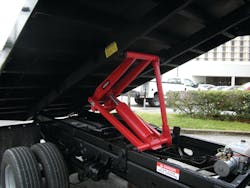Hoists are the mechanisms that raise dump bodies. Hoists come in a variety of shapes, types, sizes and styles. They are designed for use with various size and length bodies and for dumping capacity ratings based on body application and mounting configuration.
Typical dump hoist types include telescopic, underbody, conversion, direct mount and scissor. They can come with or without a subframe.
Low-profile hoists have a low mounting height to reduce overall bed height. They also provide a lower center of gravity and greater load-handling stability.
Twin telescopic hoists afford greater torsional stability for resistance to body twist under uneven loads, to counter the danger of off-center loads and non-level dumping conditions, and for dumping on the fly.
PTOs
Hoists are driven by power take-offs (PTOs). These are essentially an extension of a vehicle’s transmission that utilizes the engine’s power to do work. In the case of a dump truck, the PTO drives a pump to raise the dump body.
It is important to know the make and model of the transmission that will receive a PTO in order to select the appropriate PTO model.
PTOs for dumps are commonly available with electric/hydraulic pumps or with a direct mount PTO-driven gear pump.
RESERVOIRS
Then there is the matter of where to locate the hydraulic oil reservoir and what size reservoir is required. Reservoirs are available in a variety of styles, sizes and materials to suit a wide range of applications.
Reservoirs are available in both side-mount and upright configurations. They can be constructed of :
- Steel – relatively inexpensive, susceptible to moisture condensation and rust and is heavy.
- Polyethylene plastic – light in weight, can be molded in various shapes and colors and is less susceptible to moisture condensation.
- Aluminum – an attractive material and an excellent dissipater of heat.
Capacities of reservoirs start at around 15 gallons and go up.
CONTROLS
An additional consideration is where the controls for the dump body and such options as a tarp, tailgate, lift axle, spreader, plow, etc., should be mounted. Typically, these are located in the truck cab.
A best practice is to design and mount controls for ease of operation. Spec’ing a PTO engagement warning light and body in up position warning light will help with safe operation. So will a safety latch on PTO switch to prevent accidental engagement.
A modular dump body control system “gangs” all in-cab controls at one location.
About the Author

